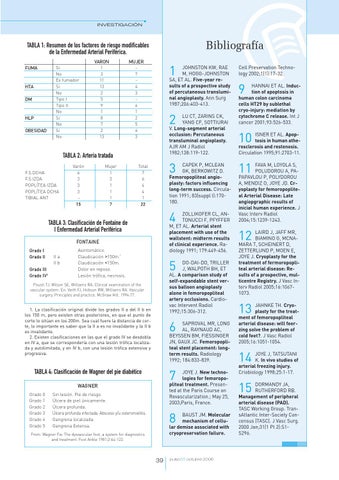INVESTIGACIÓN
Bibliografía
TABLA 1: Resumen de los factores de riesgo modificables de la Enfermedad Arterial Periférica. FUMA
HTA DM
HLP OBESIDAD
Si No Ex fumador Si No Tipo I Tipo II No Si No Si No
VARON 1 3 11 13 2 5 9 1 8 7 2 13
MUJER 7 4 3 6 1 2 5 4 3
JOHNSTON KW, RAE M, HOGG-JOHNSTON SA, ET AL. Five-year results of a prospective study of percutaneous transluminal angioplasty. Ann Surg 1987;206:403-413.
1
LU CT, ZARINS CK, YANG CF, SOTTIURAI V. Long-segment arterial occlusion: Percutaneous transluminal angioplasty. AJR AM J Radiol 1982;138:119-122.
2
TABLA 2: Arteria tratada F.S.DCHA F.S.IZDA POPLÍTEA IZDA POPLÍTEA DCHA TIBIAL ANT
Varón 6 3 3 3 15
Mujer 1 3 1 1 1 7
CAPEK P, MCLEAN GK, BERKOWITZ D. Femoropopliteal angioplasty: factors influencing long-term success. Circulation 1991; 83(suppl I):170180.
3
Total 7 6 4 4 1 22
ZOLLIKOFER CL, ANTONUCCI F, PFYFFER M, ET AL. Arterial stent placement with use of the wallstent: midterm results of clinical experience. Radiology 1991; 179:449-456.
4
TABLA 3: Clasificación de Fontaine de I Enfermedad Arterial Periférica FONTAINE Grado I Grado II Grado III Grado IV2
II a II b
Asintomático. Claudicación >150m.1 Claudicación <150m. Dolor en reposo. Lesión trófica, necrosis.
1. La clasificación original divide los grados II a del II b en los 150 m, pero existen otras posteriores, en que el punto de corte lo sitúan en los 200m. Sea cual fuere la distancia de corte, lo importante es saber que la II a es no invalidante y la II b es invalidante. 2. Existen clasificaciones en las que el grado IV se desdobla en IV a, que se correspondería con una lesión trófica localizada y autolimitada, y en IV b, con una lesión trófica extensiva y progresiva.
Grado 0 Grado 1 Grado 2 Grado 3 Grado 4 Grado 5
BAUST JM. Molecular mechanism of cellular demise associated with cryopreservation failure.
8
From: Wagner Fw. The dysvascular foot, a system for diagnostics and treatment. Foot Ankle 1981;2:64-122.
39
LAIRD J, JAFF MR, BIAMINO G, MCNAMARA T, SCHEINERT D, ZETTERLUND P, MOEN E, JOYE J. Cryoplasty for the treatment of fermoropopliteal arterial disease: Results of a prospective, multicentre Registry. J Vasc Interv Radiol 2005;16:10671073.
12
14
JOYE J. New technologies for femoropopliteal treatment. Presented at the Paris Course on Revascularization.; May 25, 2003;Paris, France.
Sin lesión. Pie de riesgo Úlcera de piel únicamente. Úlcera profunda. Úlcera profunda infectada. Absceso y/u osteromielitis. Gangrena localizada. Gangrena Extensa.
FAVA M, LOYOLA S, POLUDOROU A, PAPAPAVLOU P, POLYDOROU A, MENDIZ O, JOYE JD. Cryoplasty for femoropopliteal Arterial Disease: Late angiopgraphic results of inicial human experience. J Vasc Interv Radiol 2004;15:1239-1243.
11
SAPROVAL MR, LONG AL, RAYNAUD AC, BEYSSEN BM, FIESSINGER JN, GAUX JC. Femoropopliteal stent placement: longterm results. Radiology 1992; 184:833-839.
7
WAGNER
ISNER ET AL. Apoptosis in human atherosclerosis and restenosis. Circulation 1995;91:2703-11.
10
13
6
TABLA 4: Clasificación de Wagner del pie diabético
HANNAI ET AL. Induction of apoptosis in human colon carcinoma cells HT29 by sublethal cryo-injury: mediation by cytochrome C release. Int J cancer 2001;93:526-533.
9
DO-DAI-DO, TRILLER J, WALPOTH BH, ET AL. A comparison study of self-expandable stent versus balloon angioplasty alone in femoropopliteal artery occlusions. Cardiovac Intervent Radiol 1992;15:306-312.
5
Pousti TJ, Wilson SE, Williams RA. Clinical examination of the vascular system. En: Veith FJ, Hobson RW, Williams RA. Vascular surgery. Principles and practice. McGraw Hill. 1994:77.
Cell Preservation Technology 2002;1(1):17-32.
pulso55 octubre 2008
JAHNKE TH. Cryoplasty for the treatment of femoropopliteal arterial disease: will feerzing solve the problem of cold feet?. J Vasc Radiol 2005;16:1051-1054. JOYE J, TATSUTANI K. In vivo studies of arterial freezing injury. Criobiology 1998;25:1-17. DORMANDY JA, RUTHERFORD RB. Management of peripheral arterial disease (PAD). TASC Working Group. TransAtlantic Inter-Society Concensus (TASC). J Vasc Surg. 2000 Jan;31(1 Pt 2):S1S296.
15
